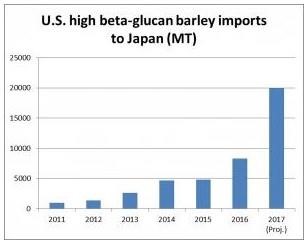Japanese diets may not match those of U.S. farmers, but the push for healthy foods in Japan is creating a small and growing high-value market for U.S. food barley.
“With Japan’s health-conscious public, the country is an excellent market for high beta-glucan U.S. barley,” said Tommy Hamamoto, USGC director in Japan. “Promoting barley as an alternative grain for the Japanese consumer has led to steadily increasing imports, increased consumer awareness and contracted sales.”
High beta-glucan barley has heart-healthy properties that may reduce cholesterol, lower the risk of heart disease and reduce glycemic index, according to U.S. research. These nutritional properties make U.S. varieties of food barley attractive for Japanese food producers who use the grain to produce shochu, a Japanese distilled liquor and beer, as well as tea and cereal.

U.S. food barley exports to Japan are worth twice the average price of feed barley, but the marketplace is very competitive. Most of the food barley consumed in the country is either grown locally or sourced from cheaper Australian supplies. The terms of the Trans-Pacific Partnership would have established an escalating tariff rate quota (TRQ) for food barley and malt in addition to eliminating the state trade of feed barley, allowing U.S. producers to better compete in this high-value market.
To help boost U.S. market share, the Council has partnered with Zenbakruen (All Japan Barley Industry Association), the Japan Food Barley Promotion Association and the U.S. Department of Agriculture’s (USDA) Foreign Agricultural Service (FAS) to promote the heart health benefits of barley with food snack companies and industry associations through educational seminars, trade teams and reverse missions.
One such activity, in September 2016, brought Japanese barley industry leaders to Idaho, North Dakota and Washington. As a result, a major Japanese food barley miller and barley food products manufacturer tested new high beta-glucan barley varieties and began contracting with U.S. producers - leading to an increase in barley food products and a corresponding increase in imports.
Click here to see more...